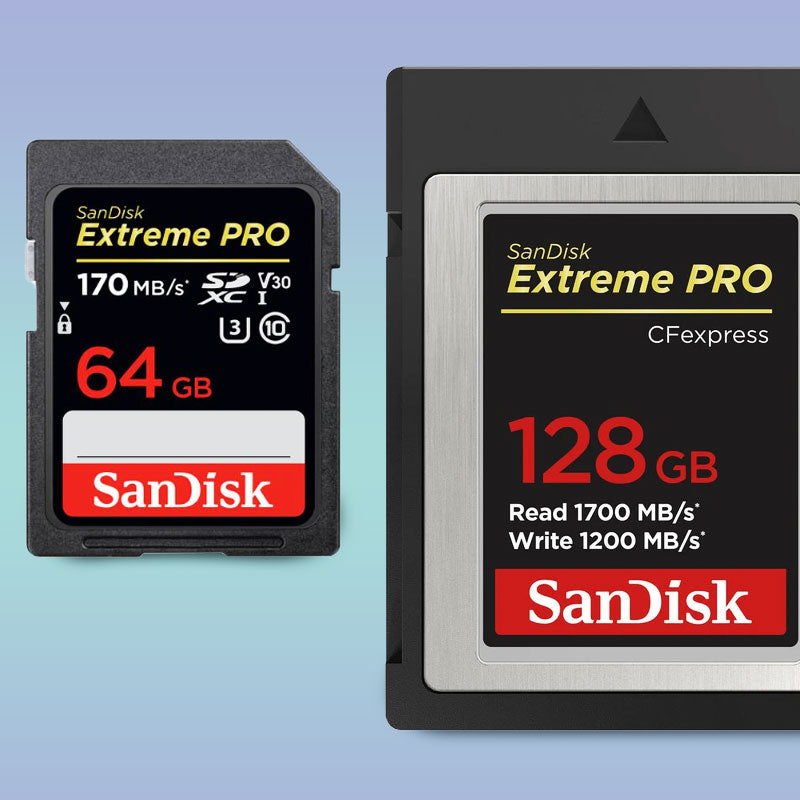No matter what digital camera you own, you will need some type of storage to hold all of the photos you take. Memory cards come in a variety of different brands, speeds and types. Some of the most well-known brands include SanDisk, Sony Tough, Delkin Devices and ProGrade. Below, we will go through some of the best practices in memory card management.
Buy the Most Compatible Cards for Your Camera
Since there are a few different types of memory cards, knowing what memory card speeds your camera is capable of is important. Not all cameras can utilize the fastest speed SD cards. They physically look the same, except for the pins on the back of the card.
For SD cards, these speeds are defined by several different metrics, but the most common are UHS-I and UHS-II ratings. UHS-II is faster and more expensive, but if your camera isn’t compatible with UHS-II, you have spent a lot of money for speeds that you won't use. Even if your camera is UHS-II compatible, if you aren’t shooting high frame rate/ high resolution video or high burst rate photos, you can easily get by with the cheaper UHS-I card.

Buy From An Authorized Dealer
Most Authorized Dealers will sell reliable memory card brands, so you shouldn’t have to worry about your card being fake or gray market. You also have educated employees to make sure you are getting the right card for your needs. Plus, if right out of the box your memory card has any sort of error, you will have a certified U.S. warranty. Most of these brands come with extra services like 48 hour replacement by Delkin Black, or data recovery services from Prograde and Sony. Plus, SanDisk Extreme Pro cards have a lifetime warranty!
Memory Card Best Practices
- Always format your memory card in camera. Formatting your card, erases all of your images. There are two ways to format your camera, in the camera itself or on the computer. However, never format a card in your computer, it doesn’t create the proper directory for your camera, and your files will not save properly.
- Don’t use one card in multiple cameras, especially different camera brands, as it can corrupt the card through incorrect directly overlap. If you have to switch cameras, always reformat the card in the new camera before using it.
- Use a memory card at least once a year. Don’t leave cards inactive for long periods of time.
- Use smaller capacities cards. You lose cards, you break cards, cards can get corrupt, etc. You don’t want to lose that large amount of data. For reference, we recommend 64GB or 32GB cards. Although, for experienced videographers, sometimes higher capacity cards are necessary.
- Always use a card reader to transfer photos. Card readers are faster and less likely to corrupt your card than using a USB cable directly from your camera to your computer.
- Don’t use a microSD card in an SD card slot in a camera. Although microSD cards are cheaper, the adapter piece isn’t designed to handle the amount of data that a camera needs. This can result in data corruption or damage to the card. Use microSD cards only in native devices like drones, action cameras, or mobile devices. The adapter piece should only be used for downloading your files on to your computer.
CFexpress vs XQD Memory Cards
The CFexpress type B and XQD memory cards have the same physical form factor, however, CFexpress cards are capable of data transfer speeds of up to 3x faster. CFexpress cards typically can hold more data as well. For example, CFexpress cards have capacity options up to 2 TB while XQD tops at 240GB. CFexpress is open-source technology, better for future compatibility and upgrades. Not all XQD cameras can use CFexpress, however many XQD compatible cameras can become CFexpress compliant through firmware upgrades. Check the manufacturer’s website for firmware updates that will allow you to enable your camera for CFexpress.
Current compatibility:
- Nikon D500, 850, D5, D6, Z6, and Z7, Z6 II, Z7 II
- Canon EOS R5, EOS 1D X III, C500 II, C300 III
- Panasonic Lumix DC-S1, and DC-S1R
For more information about CFexpress cards, check out our previous post here.

How to Store Your Memory Cards
Use a memory card holder. This keeps your memory cards protected from direct sunlight and from any type of moisture. Our favorite is the Pelican Memory Card Case. If you only have a few memory cards and don’t need a whole case, store them in the plastic cases they come in.
Label your memory cards. This can be extremely helpful when trying to remember which card has been used and which needs to be re-formatted. We’ve all heard the horror stories of someone accidentally reformatting a card with images you needed on it.
Backup Storage for Your iPhone
Since iPhone's are with us constantly, they tend to collect a lot of data for the amount of pictures we take. If you are looking to back up your iPhone’s photos and videos, we recommend using the SanDisk iXpand. It has a lightning port connector on one end to connect to your phone and a USB-C connector on the other for the computer. Use it to backup your phone entirely or just select images you want. Offloading them to a computer is easily. You can add images from your computer, and plug it in to the phone to view and share.


